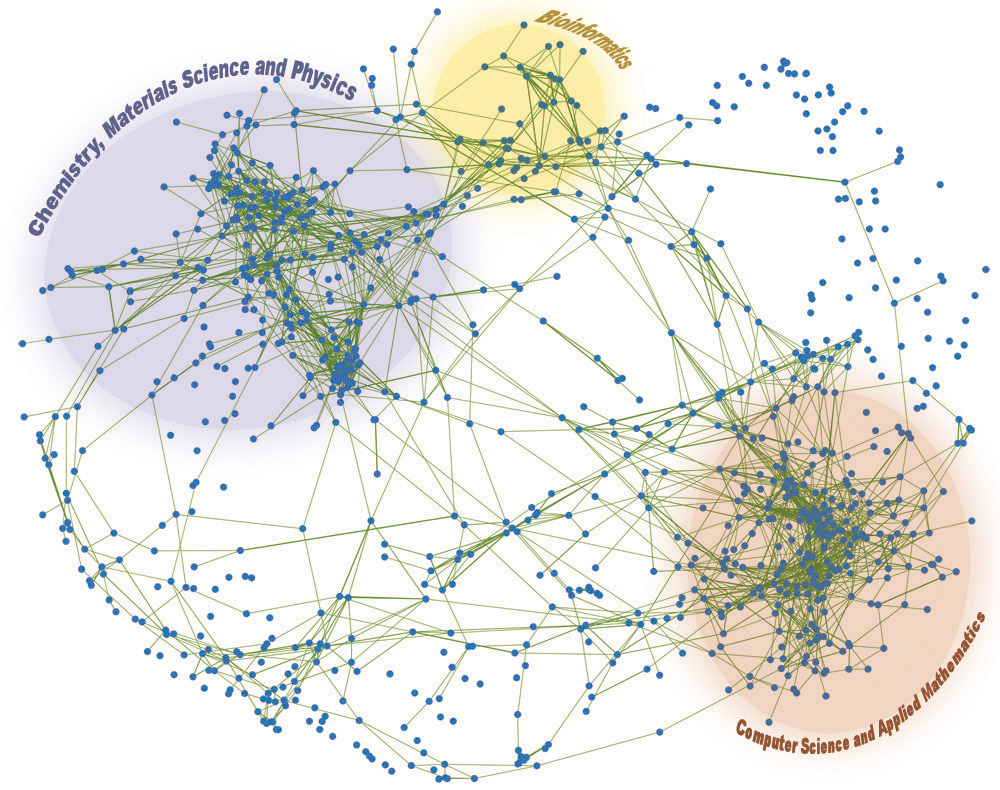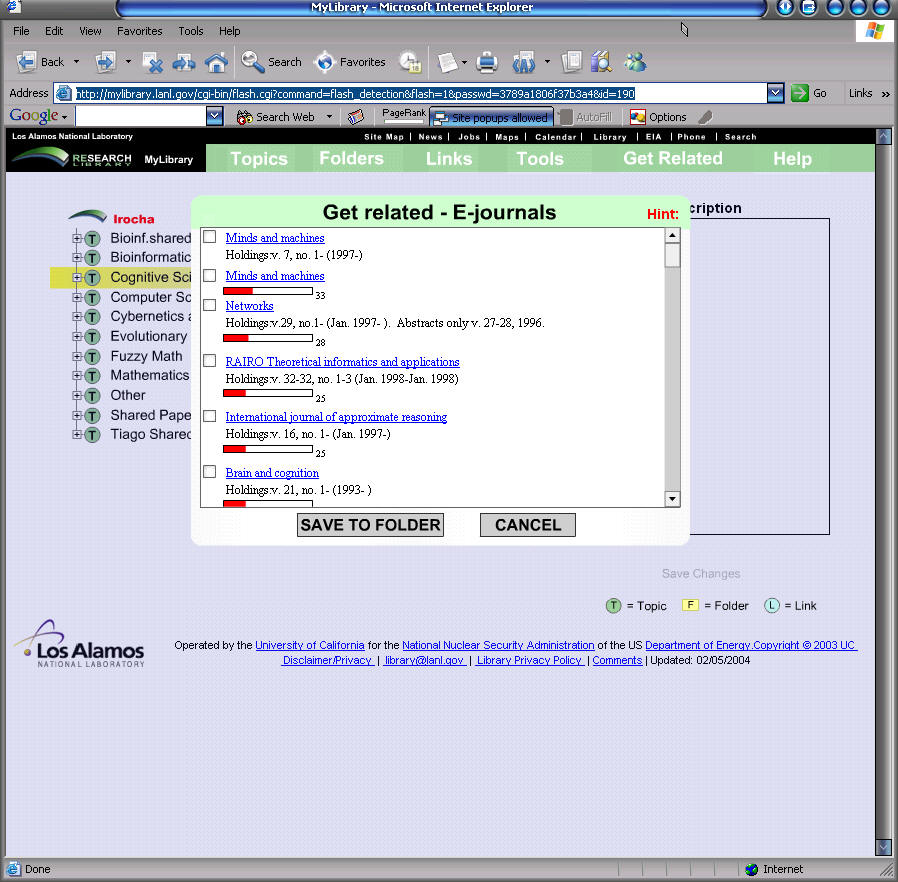Knowledge Networks & Web Intelligence
Web Intelligence, Relation Extraction, Link Prediction & Recommender Systems
We have been working on producing intelligent information retrieval methods that can pro-actively cater to the changing demands of user communities. Classic information retrieval algorithms did not effectively use the implicit knowledge accumulated from usage patterns. In other words, information retrieval used to rely exclusively on users "pulling" the information they needed from a passive environment. More recently, much effort has been posited on developing a different paradigm for information retrieval which relies much more on computational environments that "push" relevant information to users according to previous patterns of information retrieval. This has become a dominant paradigm given the large amounts of data available about user behavior that are amenable to train artificial intelligence and machine learning methods, as well as large-scale, multi-level network representations of the knowledge traded by users. This kind of information retrieval has been described as Active Collaborative Filtering, Knowledge Mining, and even Knowledge Self-Organization in distributed information systems (DIS).
We have been developing large-scale network methods for knowledge and relation inference. Using such a knowledge graph approach, we have worked on inferring associations, links, and relations in many biomedical and social problems. Our knowledge network inference (and link prediction) methods are scalable for very large networks, such as the massive knowledge graph obtained from Wikipedia which we used for automated online fact-checking [Ciampaglia et al, 2015.]. We have used them to develop active recommendation systems and user libraries for DIS based on adaptive environments which are both collaborative and content-based, as they integrate information from the patterns of usage of groups of users and also categorize database content or semantics in a manner relevant to those groups. One of these systems, TalkMine, further allows the (adaptive) transmission of information across databases, as users may search several databases at the same time. TalkMine entails an open-ended human-machine symbiosis, which can be used in the automatic, adaptive, organization of knowledge in DIS such as library databases or the Internet, facilitating the rapid dissemination of relevant information and the discovery of new knowledge. TalkMine is based on several bio-inspired mechanisms: cognitive categorization as modeled by Fuzzy Set Theory and Dempster-Shafer Theory of Evidence, a connectionist memory architecture, and Hebbian learning for adaptive memory organization.

Network of 1300 journal titles accessed by the users of the MyLibrary Web Service at the Los Alamos National Laboratory
The links shown denote a strong measure of co-occurrence (proximity) of two journals (the nodes) in user personalities. From this network, two main clusters were identified via Singular Value Decomposition: one pertaining to journals in chemistry, materials science, physics and the other to computer science and applied mathematics. A smaller cluster pertaining to journals in bioinformatics and computational biology is also highlighted. Figure better described in a recent paper describing our network approach to recommendation systems.

Web interface of the recommendation system in the MyLibrary@LANL Web Service
Figure shows journals being recommended for the "Cognitive Science" personality of a user. This system is better described in a recent paper describing our network approach to recommendation systems.
The recommendation systems we have been investigating and developing aim at the creation of adaptive knowledge networks that facilitate collaboration among individuals, each with various search personalities. Indeed, I have been particularly interested in collaborative systems that are also strong on personalization---preserving distinct search personalities for each user. The systems we have developed aim at the open-ended self-organization and adaptation of DIS to the particular, diverse needs of their users. We refer to these systems as Adaptive Webs. The TalkMine system, in particular, was originally developed for the library without walls project of the Los Alamos National Laboratory research library. A testbed for TalkMine was development under the Active Recommendation Project. Other recommendation systems based on network models have been developed and are currently implemented in the MyLibrary Web Service at Los Alamos. The figure above depicts an associative network of more than a thousand journal titles accessed by the users of MyLibrary, where the links denote strong co-occurrence associations. The figure below depicts the web interface of this service.
Funding Project partially funded by
- myAURA: Personalized Web Service for Epilepsy Management. National Institutes of Health, National Library of Medicine Program, 1R01LM012832-01, October 2018-2022
- Fundacao para a Ciencia e Tecnologia, Portugal. DSAIPA/AI/0087/2018. Project title: “Identification and Forecasting Hospital Emergency Demand”. 2018-2021
- National Science Foundation, Research Traineeship Program, NSF1735095: Interdisciplinary Training in Complex Networks and Systems, 2017-2022
- Fulbright U.S. Scholar grant, J. William Fulbright Foreign Scholarship Board (FFSB). 2016-2017
- Precision Health Initiative, "Population Health and Data and Informatics Clusters, Indiana Cohort Enhancement Study (4K Hoosiers)", Indiana University, 2017-2019
- Fundação Luso-Americana para o Desenvolvimento (Portugal), Program with National Science Foundation (USA), Proj 276/2016, 2017-2018. "Large-scale analysis of social network data for detecting drug-interaction via population behavior
- Complex Systems and Health Project Development Team, Indiana Clinical Translational Sciences Institute (ICTSI) NIH/NCRR UL1TR001108. "Sudden Unexpected Death in Epilepsy: Identifying Risk Factors with Social Media Mining" . 2016-2018
- Persistent Systems, Ltd., "Large-Scale Text and Social Data Analytics for Health", 2014-2017
- Recommendation systems for CareerBuilder.com Project, 2013.
- IARPA Contract: Early Model-Based Event Recognition with Surrogates (EMBERS), 2012-2014.
- National Science Foundation, Human and Social Dynamics Program”, 2005-2008. Project title: “DHB: Dynamics of Information Flow and Decisions in Social Networks”, with Eliot Smith, Robert Goldstone, Hugh Kelly.
Project Members (Current and Former)

Luis Rocha (PI)

Alaa Abi-Haidar

Johan Bollen

Katy Börner

Rion Brattig Correia

Jack Felag

Ziqi Guo

Artemy Kolchinsky

Ana Maguitman

Wendy Miller

Aehong Min

Jordan C. Rozum

Jon Sánchez-Valle

Tiago Simas

Alfonso Valencia

Xuan Wang
Selected Project Publications
- R.B. Correia, J.C. Rozum, L. Cross, J.Felag, M. Gallant, Z. Guo, B.W. Herr II, A. Min, J. Sanchez-Valle, D.S. Rocha, A. Valencia, X. Wang, and K.Börner, W.R.Miller, and L.M. Rocha. [2025]. "myAURA: Personalized health library for epilepsy management via knowledge graph sparsification and visualization". Journal of the American Medical Informatics Association, ocaf012. DOI: 10.1093/jamia/ocaf012. Preprint also available: arXiv:2405.05229.
- J. Sánchez-Valle, M. Flores-Rodero, F.X. Costa, J. Carbonell-Caballero, I. Núñez-Carpintero, R. Tabarés-Seisdedos, L.M. Rocha, D. Cirillo, A. Valencia [2025]. "Sex-specific transcriptome similarity networks elucidate comorbidity relationships." bioArXiv Preprint. DOI: 10.1101/2025.01.22.634077. Preprint also available: arXiv:2405.09649.
- M. De Domenico, L. Allegri, G. Caldarelli, V. d'Andrea, B. Di Camillo, L.M. Rocha, J. Rozum, R. Sbarbati, F. Zambelli [2025]. "Challenges and opportunities for digital twins in precision medicine: a complex systems perspective." npj Digital Medicine 8, 37. DOI: 10.1038/s41746-024-01402-3. Preprint also available: arXiv:2405.09649.
- Z. Guo, J. Felag, J.C. Rozum, R.B. Correia, and L.M. Rocha. [2024]. "Selecting focused digital cohorts from social media using the metric backbone of biomedical knowledge graphs.". arXiv:2405.07072. DOI: 10.48550/arXiv.2405.07072.
- A. Min, X. Wang, R.B. Correia, J. Rozum, W.R. Miller, and L.M. Rocha. [2024]. "Refinement of an Epilepsy Dictionary through Human Annotation of Health-related posts on Instagram.". arXiv:2405.08784. DOI: 10.48550/arXiv.2405.08784.
- Felag, J., Correia, R.B., Rocha, L.M. [2023]. "Discourse Polarization Increasing in Congressional Speeches: An Analysis from Clinton to Biden". Working Paper.
- J. Sánchez-Valle, R.B. Correia, M. Camacho-Artacho, R. Lepore, M.M. Mattos, L.M. Rocha, A. Valencia [2024]. "Prevalence and differences in the co-administration of drugs known to interact: an analysis of three distinct and large populations.". BMC Medicine 22: 166. doi: 10.1186/s12916-024-03384-1. PMID: 38637816.
- A. Min, W.R. Miller, L.M. Rocha, K. Borner, R.B. Correia, and P.C. Shih. [2023]. "Understanding Contexts and Challenges of Information Management for Epilepsy Care". In: Proceedings of the 2023 CHI Conference on Human Factors in Computing Systems (CHI ’23), April 23–28, 2023, Hamburg, Germany. ACM, New York, NY, USA, 15 pages. DOI:/10.1145/3544548.3580949. Preprint Available.
- I.B. Wood, R.B. Correia, W.R. Miller, and L.M. Rocha [2022]. "Small Cohort of Epilepsy Patients Showed Increased Activity on Facebook before Sudden Unexpected Death". Epilepsy & Behavior. 128: 108580. DOI:10.1016/j.yebeh.2022.108580. Preprint: arXiv:2201.07552.
- S. Zhang, H. Wu, L. Wang, G. Zhang, L.M. Rocha, H. Shatkay, L. Li[2022]. "Translational drug–interaction corpus". Database, baac031. doi: 10.1093/database/baac031.
- Simas, T., R.B Correia and L.M. Rocha [2021]. "The distance backbone of complex networks". Journal of Complex Networks. 9 (6), cnab021. DOI: 10.1093/comnet/cnab021. Preprint at: arXiv:2103.04668
- A. Min, W. Miller, L.M. Rocha, K.Börner, R.B. Correia, and P.C. Shih. [2021]. "Just In Time: Challenges and Opportunities of First Aid Care Information Sharing for Supporting Epileptic Seizure Response".Proceedings of the ACM on Human-Computer Interaction.. 5, CSCW1, Article 113, pp. 1-24. DOI:10.1145/3449187.
- R.B. Correia, I.B Wood, J. Bollen, L.M. Rocha [2020]. "Mining social media data for biomedical signals and health-related behavior". Annual Review of Biomedical Data Science . 3(1): 433-458. DOI: 10.1146/annurev-biodatasci-030320-040844.
- H.-Y. Wu, A. Shendre, S. Zhang, P. Zhang, L. Wang, D. Zeruesenay, L.M. Rocha, H. Shatkay, S. Quinney, X. Ning, and L. Li [2019]. Translational Knowledge Discovery between Drug Interactions and Pharmacogenetics. Clinical Pharmacology & Therapeutics . 2019 Dec 21. doi: 10.1002/cpt.1745
- R.B. Correia, L.P. de Araújo, M.M. Mattos, L.M. Rocha [2019]. City-wide Analysis of Electronic Health Records Reveals Gender and Age Biases in the Administration of Known Drug-Drug Interactions. NPJ Digital Medicine. 2:74
- A. Min, W.R. Miller, L.M. Rocha, K. Borner, R.B. Correia, P.C. Shih [2019]. "Understanding Health Information Management of People with Epilepsy and Their Caregivers." Workshop on Interactive Systems in Health Care, The ACM CHI Conference on Human Factors in Computing Systems. May 4-9, 2019, Glasgow, U.K.
- R.B. Correia, L. Li, L.M. Rocha [2016]. “Monitoring potential drug interactions and reactions via network analysis of Instagram user timeliness“. Pacific Symposium on Biocomputing. 21:492-503.
- G.L. Ciampaglia, P. Shiralkar, L.M. Rocha, J. Bollen, F. Menczer, A. Flammini [2015]. “Computational fact checking from knowledge networks.” PLoS One. 10(6): e0128193. doi:10.1371/journal.pone.0128193.
- Correia, Rion B., K. N. Chan, & L.M. Rocha [2015]. “Polarization in the US Congress.” The 8th Annual Conference of the Comparative Agendas Project (CAP). Lisbon, Portugal, June 23-24, 2015.
- T. Simas and L.M. Rocha [2015].”Distance Closures on Complex Networks“. Network Science, 3(2):227-268. doi:10.1017/nws.2015.11
- T. Simas and L.M. Rocha [2012].”Semi-metric networks for recommender systems“. 2012 IEEE/WIC/ACM International Conferences on Web Intelligence and Intelligent Agent Technology, pp. 175-179.
- T. Simas [2012] “Stochastic Models And Transitivity In Complex Networks”. Ph.D. Dissertation, Cognitive Science, Indiana University.
- Rocha, L.M., T. Simas, A. Rechtsteiner, M. DiGiacomo, R. Luce [2005]. "MyLibrary@LANL: Proximity and Semi-metric Networks for a Collaborative and Recommender Web Service". In: Proc. 2005 IEEE/WIC/ACM International Conference on Web Intelligence (WI'05), IEEE Press. IEEE Press, pp. 565-571.
- Rocha, L.M. [2003]. "Automatic Conversation Driven by Uncertainty Reduction and Combination of Evidence for Recommendation Agents ". In: Systematic Organization of Information in Fuzzy Systems. NATO Science Series. P. Melo-Pinto, H.N. Teodorescu and T. Fukuda (Eds.) IOS Press, pp 249-265.
- Rocha, Luis M. [2002]. "Semi-metric Behavior in Document Networks and its Application to Recommendation Systems". In: Soft Computing Agents: A New Perspective for Dynamic Information Systems. V. Loia (Ed.) International Series Frontiers in Artificial Intelligence and Applications. IOS Press, pp. 137-163.
- Rocha, Luis M. [2002]. "Combination of Evidence in Recommendation Systems Characterized by Distance Functions". In: Proceedings of the 2002 World Congress on Computational Intelligence: FUZZ-IEEE'02. Honolulu, Hawaii, May 2002. IEEE Press, pp. 203-208. LAUR 02-154.
- Rocha, Luis M. [2001]. "TalkMine: a Soft Computing Approach to Adaptive Knowledge Recommendation". In: Soft Computing Agents: New Trends for Designing Autonomous Systems. Vincenzo Loia and Salvatore Sessa (Eds.). Series on Studies in Fuzziness and Soft Computing. Physica-Verlag, Springer, pp. 89-116
- Rocha, Luis M. [2001]. "Adaptive Webs for Heterarchies with Diverse Communities of Users". Paper prepared for the workshop From Intelligent Networks to the Global Brain: Evolutionary Social Organization through Knowledge Technology, Brussels, July 3-5, 2001. LAUR 005173..
- Rocha, Luis M. and Johan Bollen [2001]. "Biologically Motivated Distributed Designs for Adaptive Knowledge Management". In: Design Principles for the Immune System and other Distributed Autonomous Systems. L. Segel and I. Cohen (Eds.) Santa Fe Institute Series in the Sciences of Complexity. Oxford University Press, pp. 305-334.
- Rocha, Luis M. [2001]. "Adaptive Recommendation and Open-Ended Semiosis". Kybernetes. Vol. 30, No. 5-6.
- Bollen, Johan, Luis M. Rocha [2000]. "An Adaptive Systems Approach to the Implementation and Evaluation of Digital Library Recommendation Systems." In: Research and Advanced Technology for Digital Libraries: 4th European Conference, ECDL 2000. Lectures Notes in Computer Science, Springer-Verlag, pp.356-359.
- Bollen, Johan, Hebert Van de Sompel, and Luis M. Rocha [1999]. "Mining associative relations from website logs and their application to context-dependent retrieval using spreading activation" (adobe pdf). Workshop on Organizing Web Space (WOWS), ACM Digital Libraries 99, August 1999, Berkeley, California.
- Rocha, Luis M. [1999]. "TalkMine and the Adaptive Recommendation Project". In: the Proceedings of the Association for Computing Machinery (ACM) - Digital Libraries 99. U.C. Berkely, August 1999. pp. 242-243.
- Johnson, Norman, Steen Rasmussen, Cliff Joslyn, Luis Rocha, Steven Smith, and Marianna Kantor [1998] " Symbiotic intelligence: self-organizing knowledge on distributed networks, driven by human interaction"(postscript), (pdf). Proceedings of the Sixth International Conference on Artificial Life, C. Adami, R. K. Belew, H. Kitano, C. E. Taylor (Eds.), MIT Press, pp. 403-407.
- The Global Brain and Adaptive Webs
- The Symbiotic Intelligence Project
- The Principia Cybernetica Project